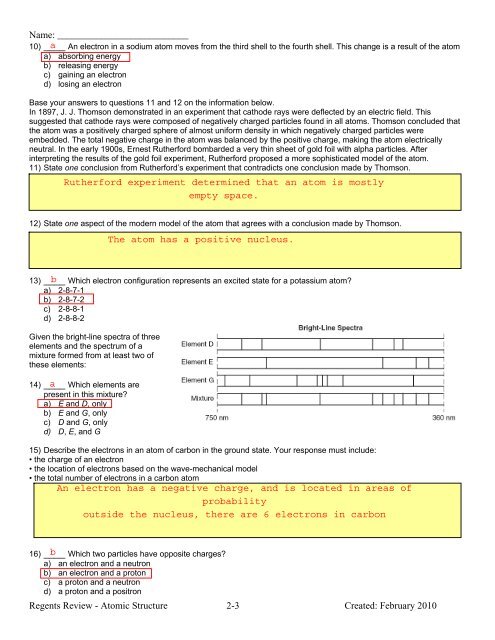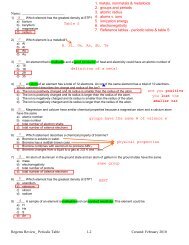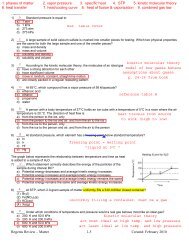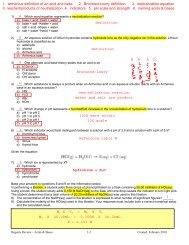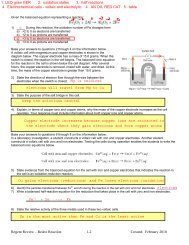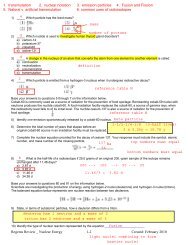Which notation represents an atom of sodium - Tully School District
Which notation represents an atom of sodium - Tully School District
Which notation represents an atom of sodium - Tully School District
Create successful ePaper yourself
Turn your PDF publications into a flip-book with our unique Google optimized e-Paper software.
Name: ___________________________<br />
10) ____ An electron in a <strong>sodium</strong> <strong>atom</strong> moves from the third shell to the fourth shell. This ch<strong>an</strong>ge is a result <strong>of</strong> the <strong>atom</strong><br />
a) absorbing energy<br />
b) releasing energy<br />
c) gaining <strong>an</strong> electron<br />
d) losing <strong>an</strong> electron<br />
Base your <strong>an</strong>swers to questions 11 <strong>an</strong>d 12 on the information below.<br />
In 1897, J. J. Thomson demonstrated in <strong>an</strong> experiment that cathode rays were deflected by <strong>an</strong> electric field. This<br />
suggested that cathode rays were composed <strong>of</strong> negatively charged particles found in all <strong>atom</strong>s. Thomson concluded that<br />
the <strong>atom</strong> was a positively charged sphere <strong>of</strong> almost uniform density in which negatively charged particles were<br />
embedded. The total negative charge in the <strong>atom</strong> was bal<strong>an</strong>ced by the positive charge, making the <strong>atom</strong> electrically<br />
neutral. In the early 1900s, Ernest Rutherford bombarded a very thin sheet <strong>of</strong> gold foil with alpha particles. After<br />
interpreting the results <strong>of</strong> the gold foil experiment, Rutherford proposed a more sophisticated model <strong>of</strong> the <strong>atom</strong>.<br />
11) State one conclusion from Rutherford’s experiment that contradicts one conclusion made by Thomson.<br />
12) State one aspect <strong>of</strong> the modern model <strong>of</strong> the <strong>atom</strong> that agrees with a conclusion made by Thomson.<br />
13) ____ <strong>Which</strong> electron configuration <strong>represents</strong> <strong>an</strong> excited state for a potassium <strong>atom</strong>?<br />
a) 2-8-7-1<br />
b) 2-8-7-2<br />
c) 2-8-8-1<br />
d) 2-8-8-2<br />
Given the bright-line spectra <strong>of</strong> three<br />
elements <strong>an</strong>d the spectrum <strong>of</strong> a<br />
mixture formed from at least two <strong>of</strong><br />
these elements:<br />
14) ____ <strong>Which</strong> elements are<br />
present in this mixture?<br />
a) E <strong>an</strong>d D, only<br />
b) E <strong>an</strong>d G, only<br />
c) D <strong>an</strong>d G, only<br />
d) D, E, <strong>an</strong>d G<br />
15) Describe the electrons in <strong>an</strong> <strong>atom</strong> <strong>of</strong> carbon in the ground state. Your response must include:<br />
• the charge <strong>of</strong> <strong>an</strong> electron<br />
• the location <strong>of</strong> electrons based on the wave-mech<strong>an</strong>ical model<br />
• the total number <strong>of</strong> electrons in a carbon <strong>atom</strong><br />
16) ____ <strong>Which</strong> two particles have opposite charges?<br />
a) <strong>an</strong> electron <strong>an</strong>d a neutron<br />
b) <strong>an</strong> electron <strong>an</strong>d a proton<br />
c) a proton <strong>an</strong>d a neutron<br />
d) a proton <strong>an</strong>d a positron<br />
Regents Review - Atomic Structure 2-3 Created: February 2010


